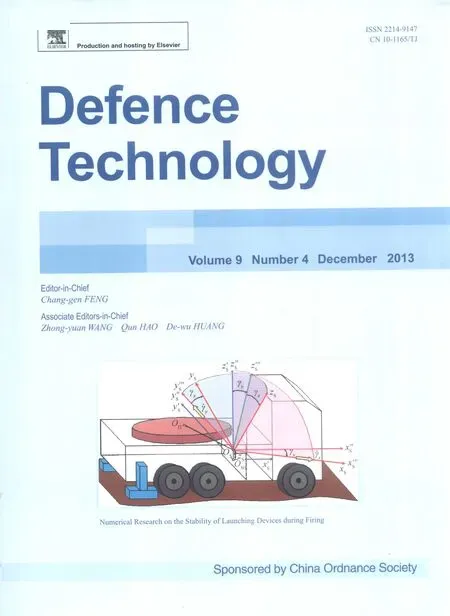Experimental Research on the Propagation Process of Continuous Rotating Detonation Wave
2013-07-25QuanZHENGChunshengWENGQiaodongBAI
Quan ZHENG*,Chun-sheng WENG,Qiao-dong BAI
Experimental Research on the Propagation Process of Continuous Rotating Detonation Wave
Quan ZHENG*,Chun-sheng WENG,Qiao-dong BAI
National Key Laboratory of Transient Physics,Nanjing University of Science and Technology,Nanjing 210094,China Available online 21 December 2013
In order to study the propagation mechanism of continuous rotating detonation wave,the H2/air continuous rotating detonation engine ignited by tangentially installed H2/O2pre-detonation tube is studied experimentally using a tilt slot injector structure.The experimental results show that the stable rotating detonation wave can be gained successfully with the equivalent ratio of 0.93.The propagation frequency and velocity of rotating detonation wave range from 5200 to 5500 Hz and from 1518.5 to 1606.1 m/s,respectively.Three propagation modes,such as rotation,reversal and bifurcation,of detonation wave are verif i ed through the analysis of propagation mechanism of rotating detonation wave.
CopyrightⒸ2013,China Ordnance Society.Production and hosting by Elsevier B.V.All rights reserved.
Continuous rotating detonation engine;Detonation wave;Slot injector;H2/air mixture;Experimental research
1.Introduction
Detonation is an eff i cient way of combustion heat release, which has many advantages of high thermodynamic cycle eff i ciency and high energy release rate.It has been highly concerned in aerospace propulsion f i eld.Currently,there are two engines adopting the detonation combustion mode:pulse detonation engine(PDE)and continuous rotating detonation engine(CRDE).Compared with PDE,CRDE can produce stable continuous rotating detonation wave just with single ignition.It has higher average fuel f l ow and higher thrust because of continuous fuel f i lling.It can also gain the characteristic of stable propagation,which reduces vibration and noise.As a result of the advantages of CRDE,it has obvious superiorities in performance,structure size,engine structure, thermal protection and other aspects[1,2].
Bykovskii et al.[3-5]studied the continuous rotating detonation.The different detonating modes,fuel-oxidant mixture and variety of engine structures were used in test.It was found that the gaseous fuel can produce continuous detonation.However,if the liquid fuel is used,it can not produce continuous detonation unless extra oxygen is added to improve the activity of mixture.Besides,they did research on many factors,such as outlet pressure,pressure losses of oxidizer and fuel,total mass f l ow rate,premixed injection structure,and put forward the design criteria of key parameters of continuous rotating detonation engine.
Rachel[6]studied the inf l uence of total mass f l ow rate and equivalent ratio on the propagation velocity of detonation wave in the air/hydrogen CRDE model with 3 in.in diameter.The results show that under the premise of keeping a certain equivalentratio,thepropagationvelocityofdetonationwaveincreases linearly with the increase in total mass f l ow rate.Jason experimentally obtained well-premixed compound and stable rotating detonation wave in the CRDE model with 6 in.in diameter by using 80 pairs of injectors with 90°injecting angle[7].Hestudied the propagation mechanism of detonation wave by photographing the f l ame head of rotating detonation wave.
Shao et al.[8,9]performed three-dimensional numerical simulation on the pre-combustion of fuel,the structure of detonation wave and propulsion performance.Jiang and Gui et al.[10,11]studied the f l ow f i eld structure in detonation waves and the detonation wave structure in CRDE.Liu et al. [12,13]analyzed the initiation process of detonation wave and the spatial structure of continuous rotating detonation wave. Liu et al.[14]did an experimental research on the initiation process of CRDE,and performed a long-term experiment to realize the continuous rotating propagation of detonation wave,the velocity of detonation wave achieved 91.14%of predicted value.Wang et al.[15]analyzed the mechanism of the formation and annihilation of the rotating detonation wave multiple wave heads.Weng et al.[2]designed a tilt slot continuous rotating detonation engine,gaining a long-term stable rotating detonation wave.
On the basis of relevant research results above,a continuous rotating detonation engine was designed by testing various injection structures.The measured pressure curve of detonation wave in CRDE was used to study the propagation mechanism,structure,and multi-wave mode of rotating detonation wave.
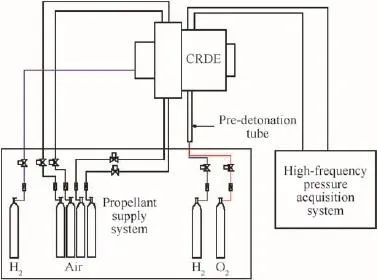
Fig.1.Schematic diagram of experimental system.
2.Experimental system
Continuous rotating detonation engine is a new concept engine.The fuel and oxidant are spurted into different plenum chambers from the front-end,are premixed through the spurting holes and the slit slot,and then are ignited by the predetonation tube.The detonation wave with a single or multiple wave heads rotationally propagates at the head of the combustion chamber during detonating.The high temperature and high pressure combustion products produced after detonation wave swell quickly and discharge from the tail of CRDE at a high velocity,thus producing a continuous thrust.CRDE experiment system consists of propellant supply system, rotating detonation chamber,pre-detonation tube and highfrequency pressure acquisition system,as shown in Fig.1. The fuel spurted into the pre-detonation tube is hydrogen,and the oxidant is oxygen.The fuel of CRDE is hydrogen,and the oxidant is air,which are spurted into different plenum chambers of the engine independently and then are spurted into the head of the annular combustion chamber through the tilt slot spurting hole structure.The mixture of the propellant has a signif i cant inf l uence on the initiation process and propagation progress of detonation wave.So the tilt slot and spurting hole structure are used to get a relatively good per-mixture effect in experiment.The tilt slot is designed in equal diameter. Hydrogen spurts through 60 tilt spurting holes with equal diameter of 0.8 mm distributing evenly on the inside cylinder. The annular combustion chamber is 83 mm in inside diameter and 93 mm in external diameter.The tilt slot and spurting hole structure is 90 mm far from the combustion chamber in order to form stable continuous rotating detonation wave.The exit of engine is connected to the air directly.
In the experiment,CRDE is ignited by tangentially installed pre-detonation tube,which increases the probability of successful initiation.The original detonation energy from the pre-detonation tube is very important to form the stable continuous rotating detonation wave.Therefore,the high activity combination of hydrogen and oxygen is used in the predetonation tube,and the high energy plasma is used to ignite. Hydrogen and oxygen are spurted into the pre-detonation tube in a crashing spouting way to get a relatively good effect of pre-mixture.The pre-detonation tube is mounted in a turbulence device which is called spoiler.The spoiler has the effect of focusing shock wave,so it can produce detonation wave with single wave head within a short distance.The distance between the tangentially injection entrance of pre-detonation tube and the tilt slot injector exit is very vital.The distance length has a direct effect on the pressure and frequency of stable detonation wave.As shown in Fig.2,the connection between pre-detonation tube and CRDE is in the middle of B and C.After ignition,the f i rst detonation wave from the predetonation tube propagates into the annular chamber anticlockwise,going through the pressure sensor 1 and then the pressure sensor 2.
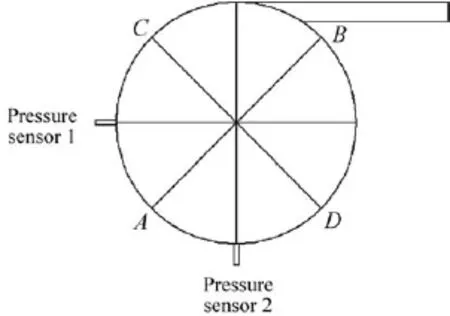
Fig.2.Schematic diagram of pressure sensor and pre-detonation tube.
The propellant system is made up by multiple pipelines. The gas pours into the main pipeline through the reducing valve,and then the propellant system provides gas for predetonation tube and engine by controlling the solenoid valve.All the switches of the solenoid valve are controlled by a self-designed singlechip which is connected to a computer. The turn-on and turn-off times of pouring gas in each channel are controlled by a self-programmed software on the computer.The pressure acquisition system,made up of pressure sensors,data lines,an acquisition card and a f i lter,is linked to the computer and controlled by a self-developed pressure acquisition software.
3.Results and analysis
3.1.Physical phenomena analysis
In the experiment,the successful initiation of CRDE is affected by ignition time,equivalence ratio and aeration time of pre-detonation tube.There is a huge difference between the successfullyinitiated fl ame andtheunsuccessfulinitiated fl ame.
Fig.3 shows a failure initiation,in which the CRDE fl ame shows pale yellow and the sound decibel of CRDE is low as a normal sound of de fl agration.The shape of unsuccessfully initiated fl ame is associated with the oxidant fl ow rate.If the oxidant fl ow rate is too small,the excess hydrogen over fl ows from the end of engine and reacts with the oxygen in air to form a de fl agration phenomenon after ignition.The shape of fl ame is turbulence,and its length is more than 1 m.When the oxidant fl ow rate is excessive,the fl ame is bundle-like and longer.According to the pressure and propagation velocity of detonation wave,we can know that the detonation was successful.The shape of successfully initiated fl ame is showed in Fig.4.The color of CRDE fl ame is light blue.Its length is shorter and the sound is harsh.
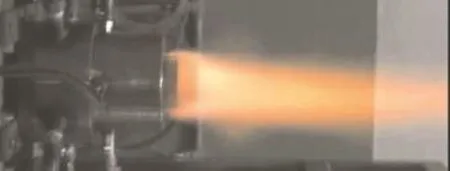
Fig.3.Schematic diagram of CRDE unsuccessful initiation.
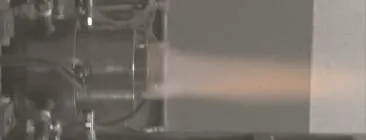
Fig.4.Schematic diagram of CRDE successful initiation.
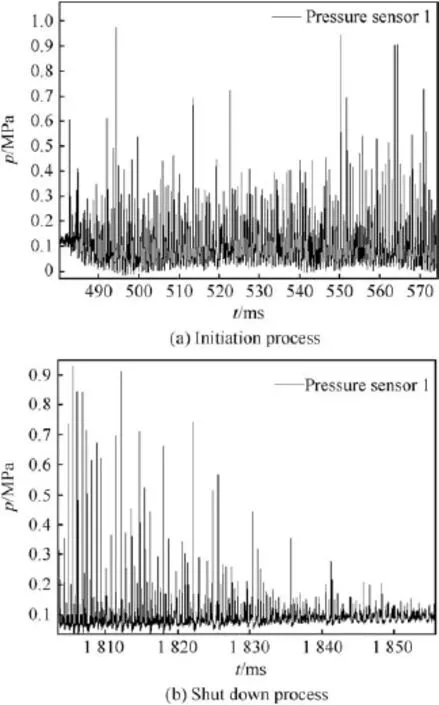
Fig.5.Initiation and shutdown processes of CRDE.
3.2.Pressure analysis
The tilt slot injector structure with 1.6 mm in length is adopted in the experiment.Fig.5(a)shows the pressure-time curves during initiation.The f i rst pressure peak is captured by pressure sensor 1 at 483 ms.The time interval between the f i rst pressure peaks captured by the pressure sensors 1 and 2 is 3.76×10-2ms.The distance between two pressure sensors is a quarter of the annular combustion chamber circumference. Therefore,the propagation velocity of initial detonation wave from the pre-detonation tube is 1837.23 m/s.The f i rst detonation wave ignites hydrogen/air premixed gas in CRDE after entering the CRDE chamber,but it can’t form the stable rotating detonation wave.The combustion products of predetonation tube then enter the CRDE chamber within tens of milliseconds,and cause a disturbance in the f l ow f i eld.According to different test conditions,one or more detonation waves will appear at the head of combustion chamber during initiation.The results show that there is a certain time interval between the f i rst detonation wave entering CRDE and the stable rotating detonation wave.The time interval ranges from several milliseconds to tens of milliseconds,which depends on the initiation energy from the pre-detonation tube.Fig.5(b) shows the pressure-time curves during engine shutdown.The activity of fuel composition falls rapidly by cutting off the fuelhydrogen and continuously jetting air in the experiment.The engine quickly extinguishes because the rotating detonation wave is unable to keep propagating.
Fig.6 shows the pressure-time curves during stable detonation.The air and hydrogen f l ow rates are 266.25 g/s and 6.5 g/s,respectively,with an equivalent ratio of 0.93.The pressure and propagating velocity of rotating detonation wave are0.45MPa-0.95MPaand1518.5m/s-1606.1m/s, respectively.The high frequency of rotating detonation wave oscillates in the range from 5200 to 5500 Hz.The orif i ce and slot match well,obtaining a continuous rotating detonation wave which is under relatively stable pressure.The CJ detonation pressure and theoretical propagating velocity of rotating detonation wave are 1.252 MPa and 1971 m/s,respectively, when the initial pressure and temperature are standard atmospheric pressure and 300 K,respectively.The experimental data is close to the theoretical value.
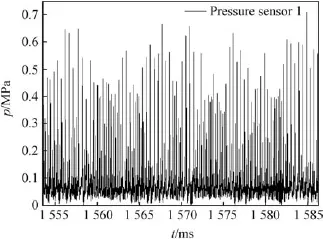
Fig.6.The stable rotating detonation waves in CRDE.
Fig.7 shows the calculation of detonation wave propagation velocity.InFig.7,t1isthetimeintervalofpressurepeakbetween pressure sensors 1 and 2.The distance between two pressure sensors is a quarter of the annular combustion chamber circumference.Therefore,the instant propagating velocity of detonation wave can be calculated by the following equation

where t1is the time interval between two adjacent pressure peaks captured by pressure sensor 1.The propagating velocity of rotating detonation wave can also be calculated by the following equation

where n is def i ned as the number of wave heads of the detonation waves.In order to comparing and analyzing the methods,the propagating velocity of detonation wave is calculated by the above two different equations during a period in which the stable rotation detonation wave is formed,as shown in Fig.6.For n=1,the propagation velocity of detonation wave calculated by v2is well consistent with the results calculated by v1,which shows that the assumption of one detonation wave head appearing in the stable stage is correct. Because the distance between two pressure sensors is too close, a large error exists if v1is used to calculate the propagation velocity of detonation wave.After verifying n=1,the propagation velocity of detonation wave is calculated by using v2in general.This method ensures that the calculation of the propagation velocity of detonation wave is accurate.
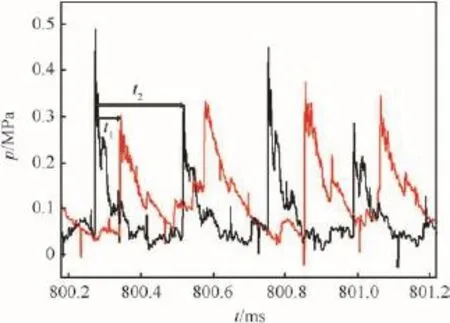
Fig.7.Calculation of detonation wave propagation velocity.
3.3.Propagation mechanism analysis
In the annular combustion chamber,the f i rst detonation wave ignites the premixed gas that is dynamically f i lled,to cause the complex phenomena and gradually form the stable rotating detonation wave.In this process,a single or multiple detonation waves may propagate in the head of annular combustion chamber.The phenomena of rotation,reversal and bifurcation of the detonation waves in CRDE are also captured in the process.During the initiation process,the rotating detonation wave with multiple wave heads is primarily generated by the shock waves ref l ected from the wall and the sharp points on the wall.The rough sharp points separate the detonation wave into sub-detonation waves which grows quickly when they meet with the fresh combustible gas mixture.The annihilation of detonation waves is caused by the decrease of f l ow rate of combustible gas mixture in the combustion chamber.
Fig.8 shows the pressure-time curves of stable rotating detonation wave with single wave head,which always exists during stable detonation.Because of the steady average annular pressure in combustion chamber,the detonation wave can propagate stably in CRDE.The fuel can be uniformly injected,which guarantees the stable propagation of rotating detonation wave with single wave head during the stabilization period.In the actual experiment,the wall of combustion chamber is heated to 1000 K-2000 K by the detonation waves.Therefore,the fresh fuel may be heated by the chamber wall in high temperature,which is good for the premixed process of fuel and oxidant[8].Fig.9 shows the propagation process of a single detonation wave.According the pressuretime curves of pressure sensors 1 and 2,the propagation direction of detonation wave is found to be counter-clockwise.
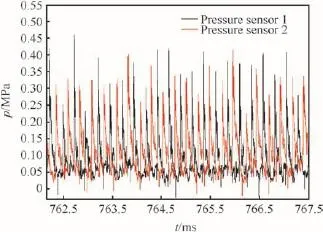
Fig.8.Pressure-time curves in the process of rotation.

Fig.9.Schematic diagram of rotation of single detonation wave.
Fig.10 shows the pressure-time curves under the reversal mode of rotating detonation wave,which always exists in the early unstable period of initiation.The propagation direction ofdetonationwaveisclockwiseintherangefrom 1409 ms-1410.5 ms,as shown in Fig.10.After that,the pressure and velocity of detonation wave reduce rapidly.The cause may be the lack of fresh fuel which is not f i lled in time. When the average pressure on the head of annular combustion chamber reduces,the fresh fuel is successfully injected into CRDE again.At this moment,a shock wave propagating in the opposite direction absorbs the energy of fresh fuel,and then forms a new detonation wave of which propagation direction is counter-clockwise.Jason C Shank observed the physical phenomena of this reversal mode of rotating detonating wave using high-speed camera system[7].Fig.11 shows the reversal of rotating detonating wave captured by the high speed camera system.
Fig.12 shows the pressure-time curves under the bifurcation mode of rotating detonation wave.It can be seen from Fig.12 that the detonation wave with single wave head rotates counterclockwise at 819.15 ms-821.2 ms.The reverse shock wave absorbs energy continuously and gradually induces a new detonation wave due to the ref l ecting effect of the wall in annular combustion chamber and the peeling off from parent detonation wave by the sharp points on the channel wall.As shown in Fig.12,the propagation velocity of detonation wave begins to change at 821.5 ms,while the pressure peaks captured by pressure sensors 1 and 2 almost entirely coincide at 822.15 ms and 822.38 ms.This phenomenon reveals that the bifurcation appears nearby Point A or Point B at the moment. Therefore,the pressure sensors 1 and 2 can capture the pressure peaks with similar size at the same time.The location of bifurcation changes continuously till 826.22 ms when the phenomenon of bifurcation disappears and a detonation wave with single wave head appears propagating in the clockwise direction.
Fig.13 shows the propagation process of bifurcation.Two detonation waves propagate in opposite directions,and collide at Point A.The collision of two detonation waves produces a high instantaneous pressure at Point A and the transmissive shock waves propagating in the combustion products on both sides of Point A.The two transmission shock waves continue to spread in the original propagation direction,absorb the energy of fresh fuel,and then gradually induce new detonation waves. Another collision occurs at Point B,and then the above process is repeated.The unstable fuel injection during the bifurcation process leads to the different velocities of two transmissive shock waves.Therefore,the collision location changes,which makes the pressure peaks captured by the two sensors move back and forth and overlap sometimes.After the rotating detonation wave with single wave head forms,the bifurcation appears again because the reverse shock wave strips the energy of detonation wave[7]to gradually induce a new reverse detonation wave.A new stable process is gained after the propagation direction of rotating detonation wave is changed.
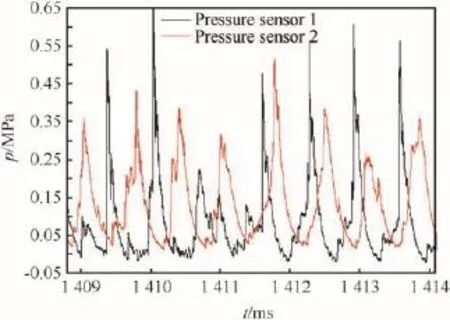
Fig.10.Pressure-time curves in the process of propagation.
4.Conclusions
The hydrogen/air continuous rotating detonation engine ignitedbytangentiallyinstalledhydrogen/oxygenpredetonation tube was studied experimentally using the tilt slot injector structure.The width of tilt slot is 1.6 mm.According to the analysis of the pressure curves and propagation mechanism ofrotatingdetonationwave,themainconclusionsareasfollows: (1)The successful initiation process of detonation combustion
and the stable continuous rotating detonation wave inCRDE were gained in the experiment.The propagation frequency of rotating detonation wave ranges from 5200 Hz to 5500 Hz,and the corresponding velocity ranges from 1518.5 m/s to 1606.1 m/s,which is close to the theoretical value.The detonation f l ame on the exit of CRDE appears light blue and shorter than the de fl agration lf ame,with a harsh sound exiting at the same time.
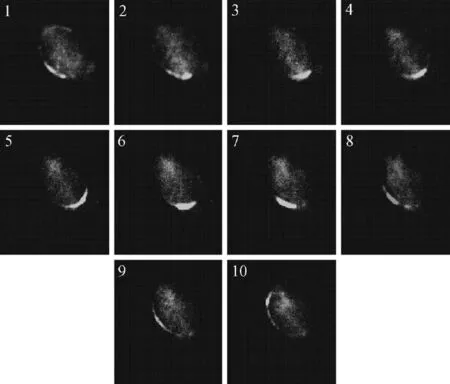
Fig.11.Reverse detonating wave captured by high speed camera[7].
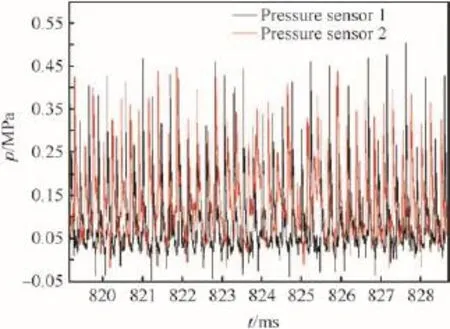
Fig.12.Pressure-time curves in the propagation process of bifurcation.
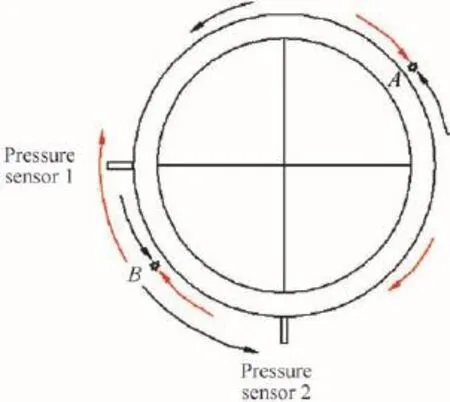
Fig.13.Schematic diagram of bifurcation of detonation wave.
(2)The initiating process,the shutdown process,and the detonation wave propagation process were analyzed tostudy the propagation mechanism of rotating detonation wave.It is found that the detonation wave operation can be grouped into three modes:rotation,reversal and bifurcation.Furthermore,the formation of the three modes was discussed.
Acknowledgment
ThisresearchwassponsoredbyNationalDefence Researching Fund(9140c300202120c30)and the FundamentalResearchFundforthecentralUniversities (30920130112007).
[1]Liu SJ,Lin ZY,Tan H,Liu WD.Advances in continuous rotating detonation engine.Winged Missiles Journal 2010;2:70-5[in Chinese]. [2]Zheng Q,Bai QD,Weng CS.Experiment research on the H2/Air continuous rotating detonation engine.In:The 6th Jiangsu Province Conference on Engineering Thermophysics 2012[in Chinese].
[3]Bykovskii FA,Zhdan SA,Vedernikov EF.Continuous spin detonations.J Propuls Power 2006;22(6):1204-16.
[4]Bykovskii FA,Zhdan SA,Vedernikov EF.Continuous spin detonation of fuel-air mixtures.Combust Explos Shock Waves 2006;42(4):463-71.
[5]Bykovskii FA,Zhdan SA,Vedernikov EF.Continuous spin detonation of hydrogen-oxygenmixtures.CombustExplosShockWaves 2008;44(2):150-62.
[6]Rachel MR.Operational characteristics of a rotating detonation engine using hydrogen and air.Ohio:Wright-Patterson Air Force Base,Air Force Institute of Technology;2011.
[7]Jason CS.Development and testing of a rotating detonation engine run on hydrogen and air.Ohio:Wright-Patterson Air Force Base,Air Force Institute of Technology;2012.
[8]Shao YT,Wang JP,Tang XM,Shi TY.Three-dimensional numerical simulation of continuous rotating detonation engine f l ow f i elds.J Aerospace Power 2010;25(8):1717-22[in Chinese].
[9]Shao YT,Liu M,Wang JP.Numerical simulation of continuous rotating detonationengineincolumncoordinate.JPropulsTechnol 2009;30(6):717-21[in Chinese].
[10]Jiang XH,Fan BH,Dong G,Chen ZH,Li HZ.Numerical investigation on the f l ow f i eld of rotating detonation wave.J Propuls Technol 2007;28(4):403-7[in Chinese].
[11]Gui MY,Fan BC,Zhang XD,Pan ZH,Jiang XH.Three-dimensional simulationofcontinuousspindetonation.JPropulsTechnol 2010;31(1):82-6[in Chinese].
[12]Liu SJ,Lin ZY,Sun MB,Liu WD.Two-dimensional numerical simulationofrotatingdetonationwaveengine.JPropulsTechnol 2010;31(5):634-40[in Chinese].
[13]Liu SJ,Qin H,Lin ZY,Sun MB,Liu WD.Detailed structure and propagating mechanism research on continuous rotating detonation wave.J Propuls Technol 2011;32(3):431-6[in Chinese].
[14]Liu SJ,Lin ZY,Lin W,Zhou ZL,Liu WD.Experiment on the ignition and propagation processes of H2/air continuous rotating detonation wave. J Propuls Technol 2012;33(3):483-9[in Chinese].
[15]Wang YH,Wang JP,Li YS,Li Y.Produce and annihilation of the multiple rotating detonation wave.In:The 15th National Conference on Shock Wave and Shock Wave Tube 2012[in Chinese].
*Corresponding author.
E-mail address:quanta_2003@163.com(Q.ZHENG). Peer review under responsibility of China Ordnance Society
Production and hosting by Elsevier
2214-9147/$-see front matter CopyrightⒸ2013,China Ordnance Society.Production and hosting by Elsevier B.V.All rights reserved. http://dx.doi.org/10.1016/j.dt.2013.11.003
杂志排行
Defence Technology的其它文章
- Effect of Hardfacing Consumables on Ballistic Performance of Q&T Steel Joints
- Numerical Research on The Stability of Launching Devices During Firing
- Contact Force Distribution and Static Load-carrying Capacity of Large Size Double Row Four-point Contact Ball Bearing
- Study on Random Initiation Phenomenon for Sympathetic Detonation of Explosive
- Analysis of Micro-scale Flame Structure of AP/HTPB Base Bleed Propellant Combustion
- Rough Sets Probabilistic Data Association Algorithm and its Application in Multi-target Tracking
